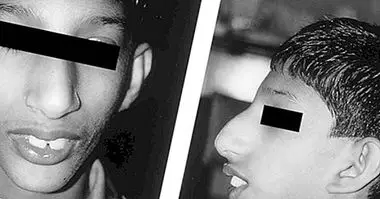Personality Dissociative Identity Disorder (TIDP)
The Personality Dissociative Identity Disorder (TIDP) It is a complex disorder that has been little studied and represents a challenge for clinical professionals. The complexity lies partly in the difficulty in identifying it. Therefore, many cases are lost in anonymity.
Personality Dissociative Identity Disorder: what is it?
One of the first challenges that TIDP patients face in therapy is that they usually receive incomplete or simply wrong diagnoses. Incomplete in the sense that they may be relevant with respect to any of the alter egos, while inadequate in the context of multiplicity.
Many people with Personality Dissociative Identity Disorder never go to psychological or psychiatric consultation. And, when they do, they often get the wrong diagnosis. They find it impossible to receive the help they need.
What is the TIDP?
Among the specialists of this disorder, he is Valerie Sinason , psychoanalyst and director of the Clinic for studies of dissociation. She is the editor of the book "Attachment Trauma and Multiplicity" and in her introduction, she comments:
"In the last decade I have advised and treated children and adults, especially women, who have Personality Dissociative Identity Disorder (TIDP)." There is a very significant bias regarding the sex of people with this condition. victims of abuse are more likely to externalize their trauma, although both sexes use exteriorization responses.Most of the children and adults that I have evaluated have been wrongly diagnosed as schizophrenic, borderline, with an antisocial or psychotic disorder ... Despite the fact that the antipsychotic medication had little or no effect on them, that the voices they heard came from within and not from outside, and that they did not exhibit a disturbance of thought about time and place, except when they were In a state of trance, despite all this, the mental health professionals did not perceive failures in the diagnosis. At the level of social denial, some patients have managed to conceal their multiplicity when they have been accused of inventing it. In response to the key question concerning the small number of children with severe dissociated states, some patients confirmed the negative responses to their child confessions that led them to hide the symptoms. These children were told that it would happen to them and that it was a phenomenon of imaginary friends "(2002, p.5).
Dissociation
The purpose of the concept of dissociation: refers to process of encapsulating or separating the memory or emotion that is directly associated with the trauma of the I conscious . Dissociation is a creative way of keeping something unacceptable out of sight. Personality Dissociative Identity Disorder is a form that the internal system creates to protect secrets and continually learns to adapt to the environment. It is a survival mechanism. Likewise, it favors and maintains attachment with the abuser. It allows, at the mental level, some conflicting emotions to be kept in separate compartments.
More specifically, dissociation involves a wide variety of behaviors that represent lapses in the cognitive and psychological process . The three main types of dissociative behavior that have been recognized are: Amnesia, absorption and depersonalization.
- The dissociative amnesia It implies suddenly finding yourself in a situation or having to face the evidence of having performed actions that the person does not remember.
- The absorption It implies getting involved so much in what is being done that the person forgets what is happening around them.
- The depersonalization it refers to experiencing events as if the individual were an observer, disconnected from the body or feelings.
Causes
North et al. (1983, cited by Sinason p.10) found that this condition was not only linked to a high percentage of child sexual abuse, but also to an occurrence between 24 and 67% of sexual abuse in adult life, and between 60% and 81% of suicide attempts.
It is clear that the TIDP is an important aspect of the grouping of conditions caused by traumas. In the USA, in a sample of 100 patients with TIDP, it was found that 97% of them had experienced major traumas in childhood and almost half of them had witnessed the violent death of someone close to them. (Putman et al., 1986, cited by Sinason p.11)
Until very recently, it has been extremely difficult to document children's cases of TIDP. Although some argue that this does not mean that they do not exist.The same happens with adolescent cases and it is only the cases of TIDP adults that receive the support of the scientific community.
Richard Kluft believed that his efforts to find the trace of the natural history of the TIDP had little success. His attempts to find children's cases were an "unmitigated fiasco". He described the case of an 8-year-old boy who appeared to manifest "a series of developed personality states," after witnessing a situation in which someone almost drowned in water, and suffered physical abuse. However, he realized with other colleagues that his field of vision was too narrow. He noticed that Gagan and MacMahon (1984, cited by Bentovim, A. p.21) described a notion of an incipient multiple personality disorder in children; They raised the possibility of a broader spectrum of dissociative phenomenology that children could manifest.
Diagnostic criteria of the TIDP
The DSM-V criteria specify that the TIDP manifests with:
- The presence of one or more distinct identities or personality states (each with its relatively stable perception patterns, in relation to, and thinking about the environment and the self.
- At least two of these identities or personality states take control of the person's behavior recurrently.
- The inability to remember important personal information that is too widespread to be explained by ordinary forgetting and that is not due to the direct effects of a substance (eg loss of consciousness or chaotic behavior during intoxication with alcohol) or a condition general medical (eg, complex partial seizures).
Guidelines for diagnosis and treatment
Regardless of the diagnosis, if the dissociation is present, it is important to explore what role plays in the patient's life . Dissociation is a defense mechanism.
It is important that the therapist discriminate dissociation and talk about defense mechanisms as parts of a process. The therapist can then accompany the patient in exploring the reasons why he may be using this mechanism as a defense. If the therapist approaches the issue of dissociation as soon as there is any indication of it, the diagnosis will come more easily. Using the Scale of Dissociative Experiences (DES) or the Somatoform Dissociation Questionnaire (SDQ-20) can help determine the degree and function dissociation plays in a person's life. (Haddock, D.B., 2001, p.72)
The International Society for the Study of Dissociation (ISSD) has developed general guidelines for the diagnosis and treatment of TIDP. He states that the basis for a diagnosis is an examination of the mental state that focuses on questions related to dissociative symptoms. The ISSD recommends the use of instruments for the dissociative review, such as the DES, the interview program for dissociative disorders (DDIS) and the structured clinical interview for the dissociative disorders of the DSM-IV.
The DDIS, developed by Ross, is a highly structured interview covering topics related to the TIDP diagnosis, as well as other psychological disorders. It is useful in terms of the differential diagnosis and provides the therapist with the average of the scores in each subsection, based on a sample of TIDP patients who answered the inventory. The SCID-D-R, developed by Marlene Steinberg, is another highly structured interview tool used to diagnose dissociation.
An important aspect of Steinberg's work consists of the five central dissociative symptoms that must be present to diagnose a person TIDP or TIDPNE (non-specific). These symptoms are: dissociative amnesia, depersonalization, derealization, confusion of identity and alteration of identity.
The TIDP is experienced by the dissociator as confusion in identity (while the non-dissociative typically experiences life in a more integrated way). The TIDP experience is composed of the dissociator feeling frequently disconnected from the world around him, as if he were living in a dream at times. The SCID-D-R helps the clinician identify the specific aspects of this story.
Diagnosis
In any case, the basic components of the therapist related to the diagnostic process include, but are not limited to the following:
A comprehensive history
An initial interview that can last between 1 and 3 sessions.
A special emphasis on matters related to the family of origin, as well as to the psychiatric and physical history . The therapist must pay attention to the memory gaps or inconsistencies found in the patient's accounts.
Direct observation
It is useful to make notes regarding the amnesia and the avoidance that is occurring in the session. It is also necessary to appreciate the changes in the facial characteristics or the quality of the voice, in case it seems out of context to the situation or to what is being treated at that moment.Note a state of extreme sleep or confusion that interferes with the patient's ability to follow the therapist during the session (Bray Haddock, Deborah, 2001, pp. 74-77)
Review of dissociative experiences
If it is suspected that there may be dissociation, a review tool such as DES, DDIS, SDQ-20 or SCID-R could be used to collect more information.
Note symptoms related to amnesia, depersonalization, derealization, identity confusion, and altered identity before diagnosing TIDP or TIDPNE.
Differential diagnosis to rule out specific disorders
You can start by considering the previous diagnoses. That is, taking into account the number of diagnoses, how many times the patient has received treatment, objectives achieved in previous treatments. Previous diagnoses are taken into consideration although they are not used, unless they currently meet the criteria of the DSM.
Then we must compare the criteria of the DSM with each disorder that has dissociation as part of its composition and diagnosing TIDP only after observing the change of alter egos.
Find out if there is a presence of substance abuse and eating disorders. If it is suspected that there may be dissociation, using a review tool such as the CD or the ED can get a greater perspective regarding the function of the dissociation process.
Diagnostic confirmation
If the dissociation is confirmed, once again comparing the DSM criteria in terms of possible diagnoses and the diagnosis of the TIDP, only after observing the relief of the alter egos. Until then, the most appropriate diagnosis will be Dissociative Identity Disorder of Non-Specific Personality (TIDPNE) or Posttraumatic Stress Syndrome (SEP).
Bibliographic references:
- Bray Haddock, Deborah, 2001. The dissociative identity disorder. Sourcebook. McGrow-Hill Publishers, New York.
- Fombellida Velasco, L. and J.A. Sánchez Moro, 2003. Multiple personality: a rare case in forensic practice. Forensic Medicine Notebooks. Sevilla Spain.
- Orengo García, F, 2000. Prevalence, diagnosis and therapeutic approach of the dissociative identity disorder or multiple personality disorder. www.psiquiatria.com
- Rich, Robert, 2005. Got parts ?: An insider's guide to managing life successfully with dissociative identity disorder. ATW and Loving Healing Press. USES.
- Sinason, Valerie, 2002. Attachment, trauma and multiplicity. Working with Dissociative Identity Disorder. Routledge, UK.



















